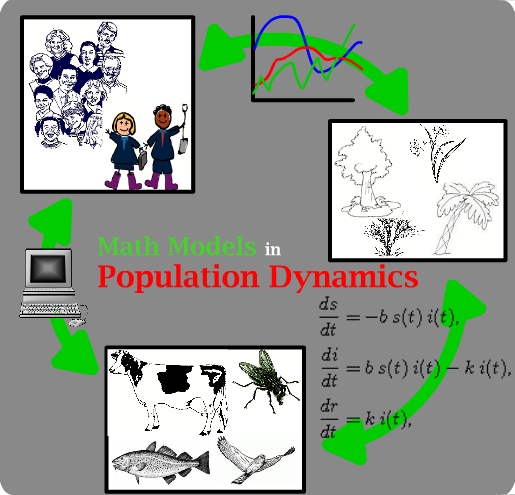Discontinuous Population Dynamics
Population dynamics is the branch of mathematical biology that solves biological problems by means of mathematical models.
It studies the changes in the size of populations and describes the factors leading to those changes.
 Theory of differential equations plays an important role for addressing many fundamental questions in population dynamics. However,
it is well recognized that models of population dynamics, under certain conditions, do not satisfy realities and they are not suitable to be considered
continually. Naturally, more realistic models of populations should take discontinuous characteristics such as impulsive effects due to harvesting, migration
or epidemics, and the effects of time delays into account. These models can be constructed using differential equations with discontinuities: impulsive differential
equations, differential equations with piecewise constant argument of generalized type and differential equations with discontinuous right-hand sides. Stimulated by
real phenomena, the need to establish a comprehensive theory for differential equations with discontinuities increases, and this, in turn, enables us to handle more
realistic models with some kind of discontinuity. In fact, the study of more realistic mathematical models in population ecology are essential in order to understand
the population dynamics better and to make practical predictions. In this light, it is worthwhile to investigate several qualitative problems such as stability,
bifurcation of periodic solutions, chaos, permanence and persistence for discontinuous population dynamics.
Theory of differential equations plays an important role for addressing many fundamental questions in population dynamics. However,
it is well recognized that models of population dynamics, under certain conditions, do not satisfy realities and they are not suitable to be considered
continually. Naturally, more realistic models of populations should take discontinuous characteristics such as impulsive effects due to harvesting, migration
or epidemics, and the effects of time delays into account. These models can be constructed using differential equations with discontinuities: impulsive differential
equations, differential equations with piecewise constant argument of generalized type and differential equations with discontinuous right-hand sides. Stimulated by
real phenomena, the need to establish a comprehensive theory for differential equations with discontinuities increases, and this, in turn, enables us to handle more
realistic models with some kind of discontinuity. In fact, the study of more realistic mathematical models in population ecology are essential in order to understand
the population dynamics better and to make practical predictions. In this light, it is worthwhile to investigate several qualitative problems such as stability,
bifurcation of periodic solutions, chaos, permanence and persistence for discontinuous population dynamics.
 CDG
CDG